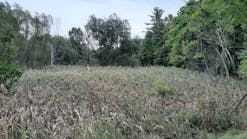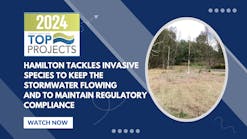Editor’s note: This article first appeared in the January 2003 of Erosion Control.
Despite all the work done by earthmoving equipment, each year wind and rain move much more soil than man could ever hope to shovel. And because soil is a finite commodity, one has to hold on to as much of it as possible.
Plantings aid in this quest; the roots of trees and forbs help bind the soil, keeping it in one spot. Some spaces, such as dirt roads and trails, however, can’t or shouldn’t be seeded, so what are the options for holding the soil? Water has traditionally been used on dirt roads for temporary dust suppression, but the oft-resultant mud not only impedes the area’s use, it can also cause more eventual erosion – the mud can be carried away on shoes, tires, or treads, and the gullies caused by heavy equipment can collect rainwater and cause washouts. If, as in the case of new home construction, the high-trafficked soil will eventually be planted, the cycle of water-mud-traffic can compact the soil so much that the homeowner will have a tough time getting anything to grow.
Many such problem areas are now being resolved by chemical intervention, with environmentally safe polymers that bind the soil, making it resistant to wind and water erosion. These surface-applied chemicals usually create cationic actions that bind dust particles together, forming a semihard surface that resists wind, rain, and the ravages of traffic.
Midwest Industrial Supply in Canton, OH, offers a number of soil-binding products for a variety of applications. Arena Rx, for example, eliminates airborne dust in equine arenas, allowing humans and horses alike to breathe more easily. Diamond Dr is a dust control agent specifically designed for ball fields. Dust Fyghter, a chloride dust suppressant, absorbs moisture from the air and locks it into the soil. Dustract breaks down water’s surface tension, increasing the attraction and encapsulation of dust particles. Hydro-Plus, which includes a wetting additive, helps eliminate heat or soil conditions that cause water to drain from seed, fertilizer, or mulch mix.
EK35 uses environmentally friendly synthetic fluids and rosins to provide a dust-suppressing weighting mechanism while acting as a durable, reworkable binder. Designed for intense-use traffic sites (even for tracked and chained vehicles) with heavy powder or surface dust, EK35 does not dry or cure but acts as a continuously active suppressant. The product, which is applied without water, works well with all aggregate materials and soil types.
Soil-Sement, one of Midwest Industrial Supply’s most popular products, prevents fugitive dust while providing erosion control. It can be applied to many surfaces and substrates, including unpaved roadways, well-graded aggregates, and clay, silty, or sandy loam soils. The product can also be used on storage piles of coal, minerals, ore, and limestone; on mine tailings, ash ponds and landfills; and on radioactive- and asbestos-containing soils. Soil-Sement can be used in compliance with PM10 air-quality and National Pollutant Discharge Elimination System stormwater requirements.
Sante Tulli, superintendent of Stavola Construction in Tinton Falls, NJ, uses Soil-Sement for dust control in housing development projects. “We spray it onto the soil out of a water truck. It looks like Elmer’s Glue when it comes out,” he says. “You get a little film atop the soil, which keeps dust to a minimum. You can walk on that film without cracking it.
“We started using it three or four years ago,” Tulli continues. “We spray it on housing development pads. If no one drives big equipment on it, it will last eight months to a year. We’re very happy with it, and it keeps the area soil erosion people happy.”
Environmental Products and Applications in Palm Desert, CA, has offered Envirotac II since 1986, producing more than a million pounds a month for a variety of applications: dust control on landfill slopes, mining operations, freeway shoulders; in power plants on dissipation ponds; and in residential neighborhoods for erosion control.
“It’s like liquid plastic. It makes the soil water-resistant; although, when used in smaller quantities, it can be used as a tackifier,” describes John Vermillion, the company’s president. “It’s easy to apply with a [hydroseeding machine] or a water truck.” Envirotac II can be added to a hydroseeding mix. “It will enhance the growth of seeds because it bonds with the seed and holds onto the dew to keep the seed moist, to aid in germination. But it won’t hold too much moisture, which could make the seed moldy. It holds a certain amount of water but blocks water out if it gets too much.”
The product poses no environmental concerns, Vermillion says. “Envirotac II is like a water-based paint – it won’t leach and is cured within 12 to 2 hours. Eventually UV [ultraviolet] light breaks it down, and it dissipates into the soil, but by then the vegetation will have grown up. In the case of mining applications, Envirotac II will be reapplied. It holds up one to three seasons, depending on the amount of rain. Other customers spray Envirotac II on coal to keep it from igniting. It’s also used for erosion and dust control, like on unpaved roads.”
The product was put to an unusual use recently during United States military operations in Afghanistan.
“We donated some to the troops in Afghanistan so they could spray it down on the sand, creating an area where they could land planes and helicopters,” explains Vermillion. Envirotac II allowed the troops to create an “instant” airstrip. It doesn’t require lengthy cure times (as does cement), and the relatively small amount of Envirotac II required eliminated the need for shipping large volumes of construction materials. It was first used at Camp Rhino, Afghanistan, on November 25, 2001; taking into account the product’s viscosity, the US Marines created a colorful name for it: “Rhino Snot.”
Part 2 of this story can be found here.






